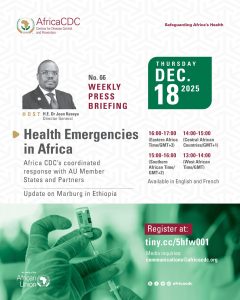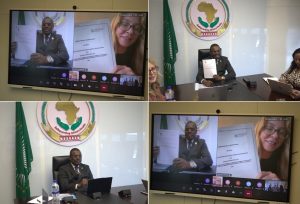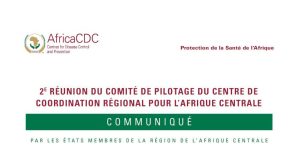Addis Ababa, Ethiopia- July 5, 2022. On 23 April 2022, the Ministry of Health of the Democratic Republic of the Congo (DRC) declared an outbreak of Ebola virus disease (EVD) after laboratory confirmation of a case, a 31-year-old male from Mbandaka, a city of approximately 1.2 million people in the north-western Equateur province. This was the 14th outbreak in the country’s history and the 3rd that has been declared in the province of Equateur. Two Health Zones of Mbandaka and Wangata were affected by the outbreak with a total of 5 cases reported (4 confirmed and 1 probable) and all have died. The affected persons were not vaccinated during previous outbreaks.
Different public health response measures were put in place, including community-based surveillance trainings for rapid response teams; Infection Prevention and Control (IPC) interventions in health care facilities and the community, psycho-social support, and risk communication and community engagement. A total 11,139 (alive) and 161 (deaths) alerts were investigated; 1,076 contacts were identified and followed; 909 laboratory samples (805 blood and 104 swab) were tested and 2,037 persons vaccinated (301 contacts vaccines, 1301 contacts of contacts and 435 Health care workers).
In response to this outbreak, the African Union Commission (AUC) through Africa Centres for Disease Control and Prevention (Africa CDC) dispatched medical supplies, and deployed experts including epidemiologists, infection prevention and control experts, and laboratory scientists to provide technical support. The last case of EVD was reported on the 19th of May 2022 and after 42 days of reinforced surveillance without any new confirmed cases, the Government of DRC declared the end of the outbreak on Sunday the 3rd of July 2022.
Africa CDC will continue to support the Government of the Democratic Republic of the Congo to strengthen surveillance activities and laboratory capacity to better prepare for, detect earlier and respond rapidly to future outbreaks.
Ebola virus disease (EVD), formerly known as Ebola hemorrhagic fever, is a severe, often fatal illness affecting humans and other primates. The virus is transmitted to people from wild animals (such as fruit bats, porcupines and non-human primates) and then spreads in the human population through direct contact with the blood, secretions, organs or other bodily fluids of infected people, and with surfaces and materials (e.g., bedding, clothing) contaminated with these fluids
About the Africa CDC: The Africa CDC mission is to strengthen Africa’s public health institution’s capacities, capabilities and partnerships to detect and respond quickly and effectively to disease threats and outbreaks based on science, policy, and data-driven interventions and programmes. Learn more at: https://africacdc.orgAbout the African Union: The African Union spearheads Africa’s development and integration in close collaboration with African Union Member States, the Regional Economic Communities and African citizens. AU Vision: to accelerate progress towards an integrated, prosperous and inclusive Africa, at peace with itself, playing a dynamic role in the continental and global arena, effectively driven by an accountable, efficient and responsive Commission. Learn more at: http://www.au.int/en/







